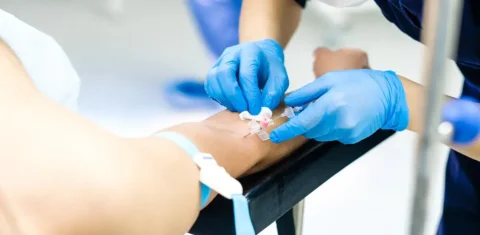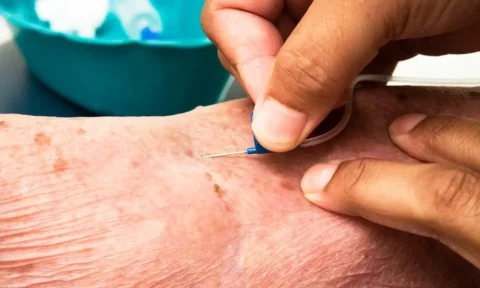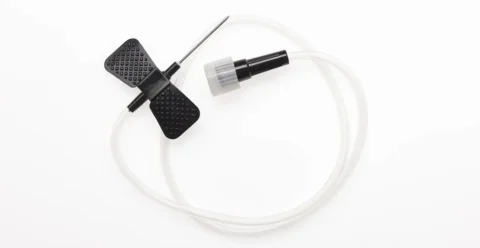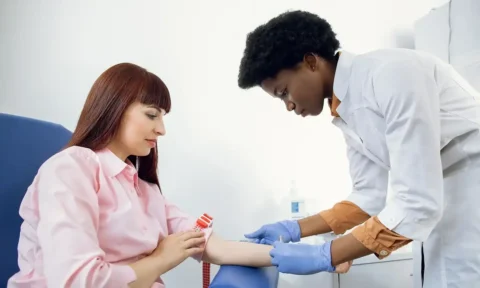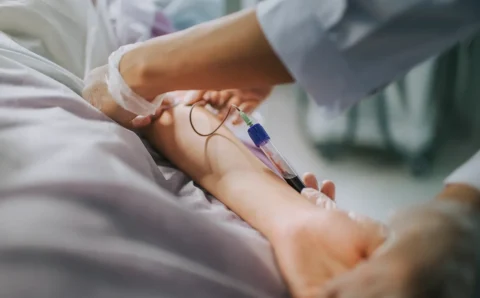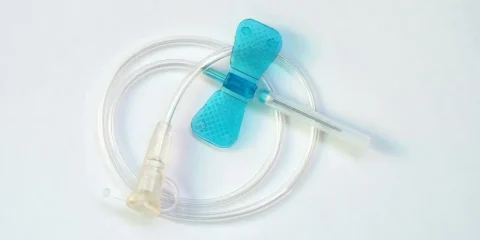Butterfly needles are medical devices that a healthcare provider may use to access smaller or rolling veins for IV hydration, blood draw, or medication administration. However, there might be some situations when a straight needle is a better choice than the winged infusion set – such as the blood test for prenatal testing patients.
So why can’t butterfly needles be used for venipuncture needed for prenatal testing? Butterfly needles have a unique design that isn’t ideal for blood collection used for prenatal testing. Using these needle sets may result in possible venous damage and hemolysis, which affects the quality of the blood sample. They also tend to be slow when collecting blood and difficult to insert into the skin and vein.
Why You Shouldn’t Use Butterfly Needles for Blood Collection for Prenatal Testing
Prenatal testing, diagnosis, and screening are important medical tools that help doctors evaluate the health of a fetus before birth. It helps them detect any congenital anomalies or genetic disorders early on so patients can take the necessary steps to keep themselves and their babies healthy.
A prenatal test can be anything from a simple blood work test to a chorionic villus sampling or amniocentesis. Since it’s such an important medical procedure, healthcare professionals should ensure that every step should be performed correctly – from choosing the right needle size to interpreting the results of the blood sampling.
Venipuncture or blood sample collection is an important part of prenatal testing that requires drawing blood from the patient’s arm. A medical professional typically uses a straight needle and syringe to collect the required amount of blood. Butterfly needles or winged infusion sets may also be used, but they’re not exactly the best choice because of the following reasons:
1. Slow Blood Collection
The blood flow from the blood vessels into the collection tube is usually slower when using a butterfly needle set because of its small needle size. This isn’t favorable for patients who easily feel squeamish at the sight of needles, blood, or just the entire venipuncture process in general.
And while feeling sick during blood collection is a normal vasovagal reaction for some people, pregnant women may experience more queasiness because of the other changes in their bodies. They need to get the blood collection process over with quickly so they won’t feel nauseous anymore.
2. Possible Venous Damage
Butterfly needles come with plastic wings that phlebotomists use to hold the needle better and place it accurately into the blood vessels. However, the thin needle can only be inserted into the vein at a shallow angle. While the wings are meant to stabilize the needle after its placement, the butterfly needle is still delicate enough that it may easily be yanked away with a little more force.
This kind of needle injury may result in venous damage known as a “blown vein.” Most cases of blown veins have no long-term damage to the patient’s overall health, but the results of the blood test can be greatly affected.
3. Higher Risk of Hemolysis
The higher the number of the needle gauge is, the thinner the needle and the smaller the hole will be. Smaller gauge needles are less likely to cause pain or discomfort for patients as they pierce the skin, but they may still increase the risk of hemolysis (destruction of red blood cells) and coagulation (blood clotting or clumping of platelets).
Hemolysis refers to the breakage of the red blood cell membrane, which causes the hemoglobin and other important components of the cell to leak into the surrounding fluid. Red blood cells are extremely fragile so even the slightest increase in pulse pressure can cause hemolysis. Unfortunately, this issue can’t easily be detected until the collection tube containing the blood sample has been spun.
Hemolyzed blood samples have an orange or red hue. Although some degree of hemolysis is acceptable, blood might need to be drawn again in some cases so the test results won’t be affected.
4. Difficult Needle Insertion
In some cases, it may be difficult to insert the butterfly needle into the skin and vein properly. Since it has a short needle, the user may accidentally pull it back from the vein. When this happens, the venipuncture must be repeated with a new stick.
To prevent the occurrence of unintended sticks, some butterfly needles come with a “push button” function that allows the healthcare professional to easily retract the needle after the blood collection. They may also push this button before the intended time.
Does Using Butterfly Needles Affect the Prenatal Testing Results?
Yes, prenatal test results can be affected by the use of butterfly needles during phlebotomy. Since butterfly needles have a smaller needle size, there’s a higher risk that the blood cells may be destroyed as they’re extracted from the patient’s veins.
Hemolysis is a huge issue in certain blood tests because it falsely decreases the value of some blood components, like the red blood cells. It also decreases the results of certain tests like the hematocrit test and activated partial thromboplastin clotting test. Hemolysis also falsely increases the value of ammonia, magnesium, potassium, and others during laboratory testing.
With skewed values, the prenatal test results become highly inaccurate. This may be dangerous for pregnant patients and their unborn children because they need accurate laboratory testing results to make important health decisions.
Drawing Blood Using Butterfly Needles
At first look, butterfly needles look like Huber needles that also have wings. However, Huber needles are bent at a 90° angle for more secure placement. Butterfly needles are better used for IV therapy and blood collection in younger patients with narrow veins. The winged infusion set also comes with a connector that phlebotomists may attach to an evacuated tube to collect blood.
While butterfly needles aren’t recommended for prenatal testing, they may still be used in venipuncture procedures in some cases – like when the patient has smaller veins or hard-to-reach blood vessels. Additionally, phlebotomists should also be extra careful when using butterfly needles to avoid damaging the veins or hemolyzing the specimen.
1. Advantages of Butterfly Needles
Butterfly needles are known for their shallow design. They also have a size smaller than an intravenous catheter, making them ideal for accessing superficial veins near the skin’s surface. They’re the best option when accessing veins and collecting blood from patients with narrow veins – like those of infants or the elderly.
A healthcare professional may also use butterfly needles for people with spastic or rolling veins. They’re also small enough to be inserted into the smaller veins founds in the scalp, heel, hand, or foot.
Because of their small size and thin needle, winged infusion sets are also a lot less painful compared to other straight needles. This makes them ideal for people who are anxious and hesitant about needles. Butterfly needles are also less likely to cause nerve injury or profuse bleeding as long as the needle is carefully removed.
2. Recommended Butterfly Needle Sizes
Although most butterfly needles have more or less the same design, some manufacturers create variations that make some of them better suited for different functions than others. Like the standard straight needle, butterfly needles also come in gauges that range in size from 18-gauge to 27-gauge.
The best butterfly needle sizes for blood draws are 21-gauge, 22-gauge, and 23-gauge. Smaller sizes like the 25-gauge and 27-gauge only increase the rate of hemolysis, so they’re not often used for blood sampling.
- 21-gauge needles: This needle size is commonly used for venipuncture and routine blood draws. It’s small enough to collect blood quickly without causing too much pain or discomfort for the patient. Using 21-gauge needles also prevents the rupture of blood components (red blood cells, platelets, white blood cells, and others) and preserves the specimen’s integrity.
- 22-gauge needles: Some health facilities also use 22-gauge needles for routine blood draws. Their smaller size is useful for accessing the smaller veins of older children and some adult patients.
- 23-gauge needles: Most butterfly needle sets have 23-gauge needles that have light blue plastic wings. They’re usually used for infants and small children since their veins are much thinner than those of an adult. However, some older patients might also need 23-gauge butterfly needles for collecting blood in some parts of their bodies.
3. New Butterfly Needle Techniques
The use of butterfly needles for blood collection is only limited because the risks often outweigh their advantages. To solve the issue of hemolysis when using 23-gauge and 25-gauge butterfly needles, some manufacturers are starting to reconfigure their tools.
The main reason why hemolysis occurs when using small needle sizes of winged infusion sets is because of the small needle hole diameter that the blood must travel through to reach the syringe or collection tube. The solution that some manufacturers came up with is to develop butterfly needles that have the outside diameter of a 25-gauge needle with an internal diameter of a 23-gauge needle.
By decreasing the size of the needle wall and increasing the bore size, phlebotomists may reduce the rate of hemolysis in some blood specimens. This also means they may fill the collection tube more quickly, as long as the patient has good blood pressure. Patients may also experience less pain and discomfort during the blood collection as the needle maintains its small size.
4. Important Tips to Prevent Hemolysis With Butterfly Needles
Although butterfly needles aren’t often recommended for prenatal testing because they may affect the test results, there might be some cases when winged infusion sets are the better option than others for blood collection. To minimize the risk of hemolysis in the blood sample, here are some tips to follow:
- Use 23-gauge butterfly needles. Smaller gauges tend to physically damage the red blood cells that pass through the needle.
- Avoid drawing blood slowly when the butterfly needle is improperly positioned.
- Don’t shake the collection tubes containing the blood sample. Instead, gently invert each one around 6 to 8 times to ensure that the blood properly mixes with the additive.
- Make sure to collect the right amount of blood because some of the additives may cause cell rupture if the ratio is incorrect.
Step-by-Step Guide to Blood Collection Using Butterfly Needles
Aside from the choice of needle systems when performing venipuncture for prenatal tests, it’s also crucial for the phlebotomist or other medical professional to complete the procedure correctly. Here’s a step-by-step guide to help you draw blood using butterfly needles when needed:
- Prepare all the needed supplies in one place, such as the butterfly needle set, tourniquet, alcohol swabs, collection tubes, and others. Make sure to keep a few extra supplies in case you need to redo the venipuncture.
- Inspect the patient’s arm and find a suitable vein that has good turgidity.
- Clean the injection site with an antiseptic solution. Follow your facility’s instructions for preparing the puncture site when collecting blood culture samples.
- Hold the butterfly needle by the wings using your thumb and index finger. Insert the needle toward the target vein at a shallow angle.
- Check the device for a blood flash, a sign that the butterfly needle is inserted correctly into the vein.
- Stabilize the butterfly needle using the wings to prevent it from rolling or shifting.
- Prepare a gauze pad in your free hand and apply it over the injection site, but don’t apply pressure yet.
- Carefully withdraw the needle from the patient while putting the gauze over the injection site. Activate the needle’s safety feature to avoid needlestick injuries.
- Apply pressure over the puncture site to stop the bleeding. Check the injection wound after 5 to 10 seconds for a symptom of hematoma. Treat the patient further if necessary.
- Make sure to collect the blood sample based on the order of the draw. Label each specimen accordingly to avoid confusion.
- Discard the used needle into the puncture-proof container for sharp objects.
High-Quality Medical Supplies and More at FACE Med Store
Prenatal testing is an important medical procedure that helps pregnant patients create important decisions for themselves and their babies. Although butterfly needles aren’t often recommended for prenatal testing, they’re still useful in other medical purposes like IV therapy and delivering medications.
And if you need high-quality butterfly needles for your medical practice, we offer butterfly needles of different sizes at FACE Med Store. We’re the trusted partner of hundreds of medical practitioners all over the country, so you can rely on us to supply you with the best butterfly needle sets and other medical equipment you need to deliver the best services for your patients.
Call us today or visit our website to know more about us and our products.
